Abstract
The action of methotrexate, actinomycin D, bleomycin, vincristine and hydroxyurea on the production of human chorionic gonadotrophin (hCG) by a choriocarcinoma cell line (BeWo) has been studied. hCG production per unit of cell protein was increased, and this was a continuing process only halted by cell death. The proportion of hCG-producing cells in the population increased from approximately 5% to a maximum of approximately 40% during incubation with vincristine. A possible explanation for these and related observations is that cytotoxic agents promote the differentiation of cytotrophoblast to syncytium. A similar mechanism could contribute to the unusual sensitivity of choriocarcinoma to cytotoxic agents.
Full text
PDF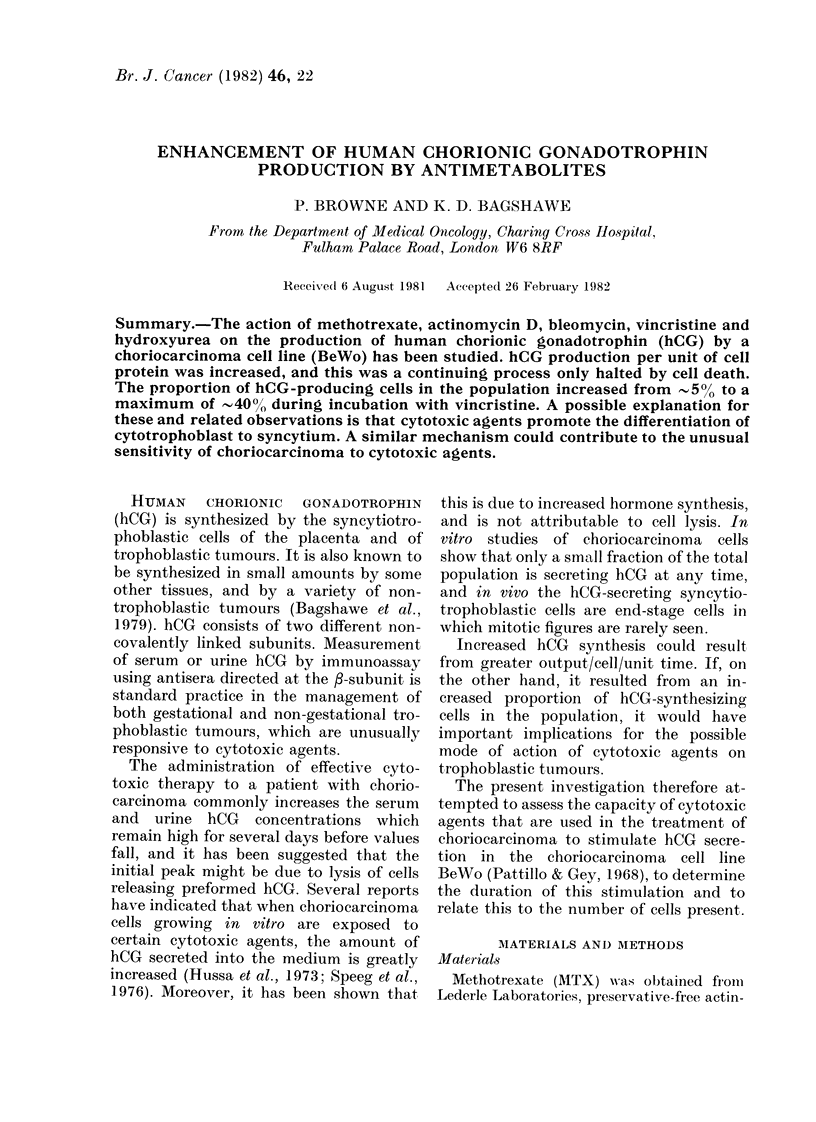
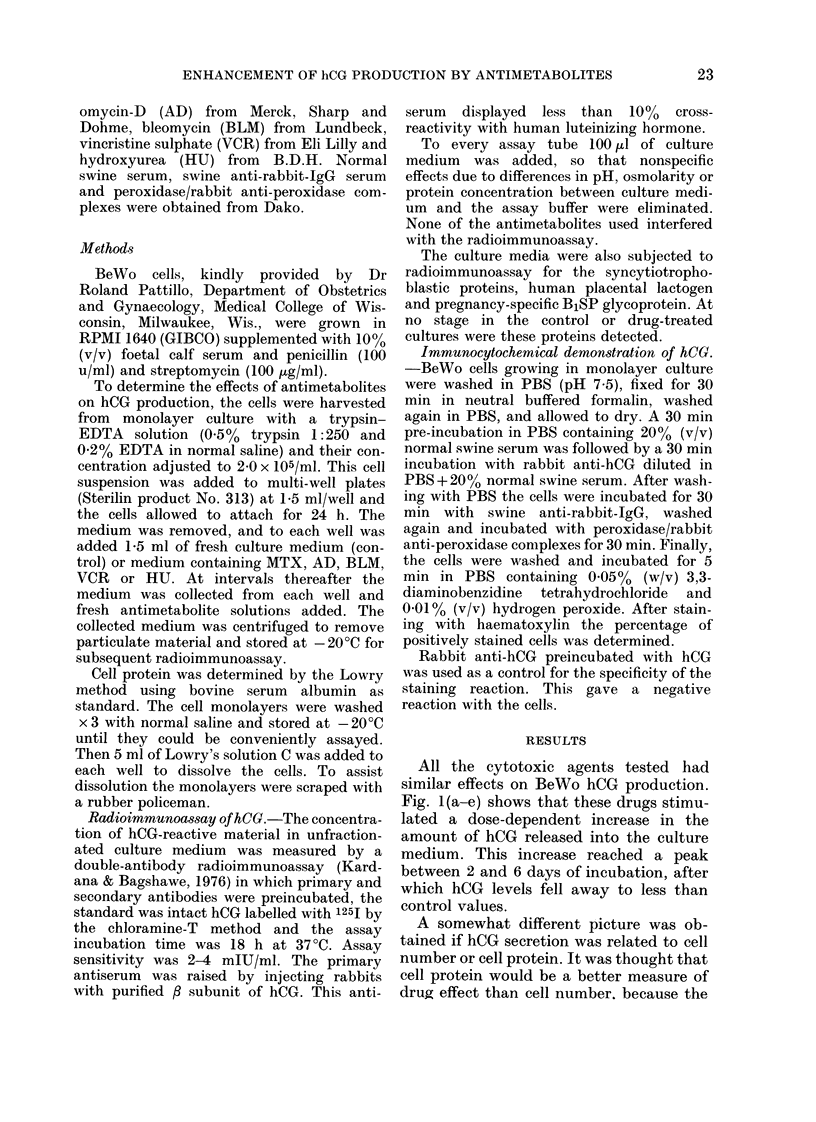
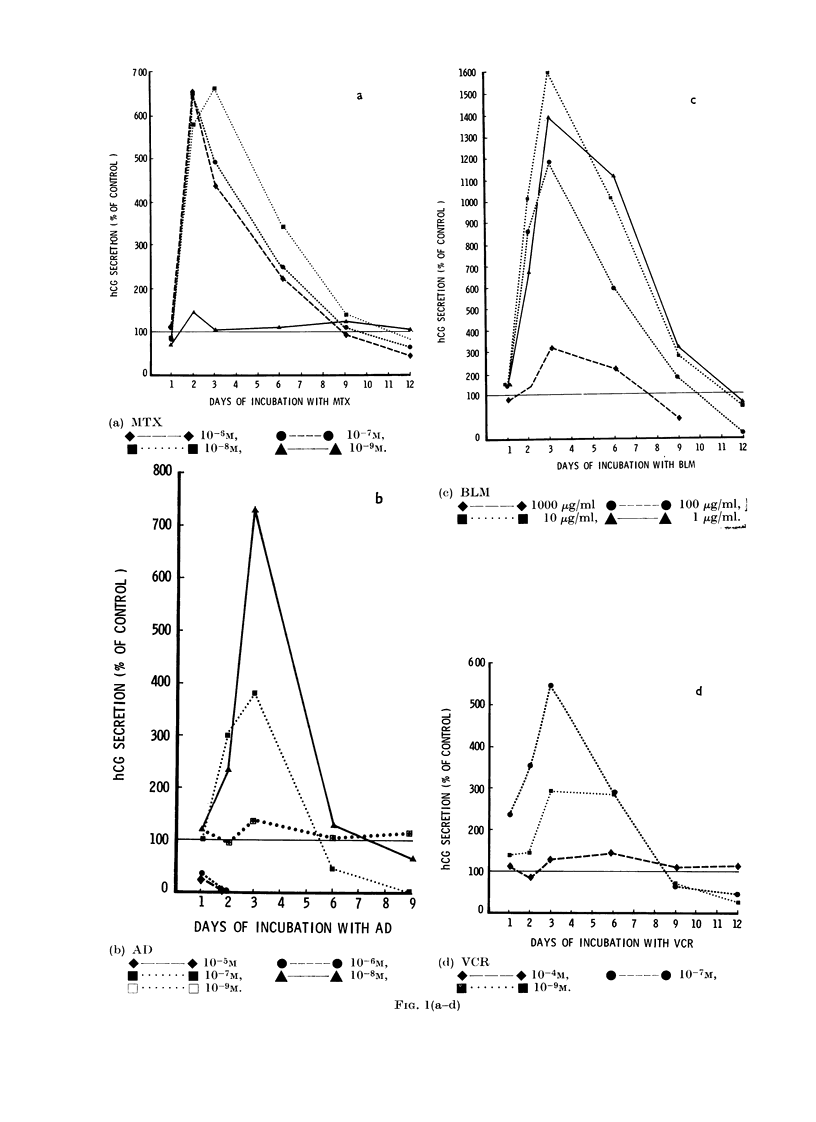

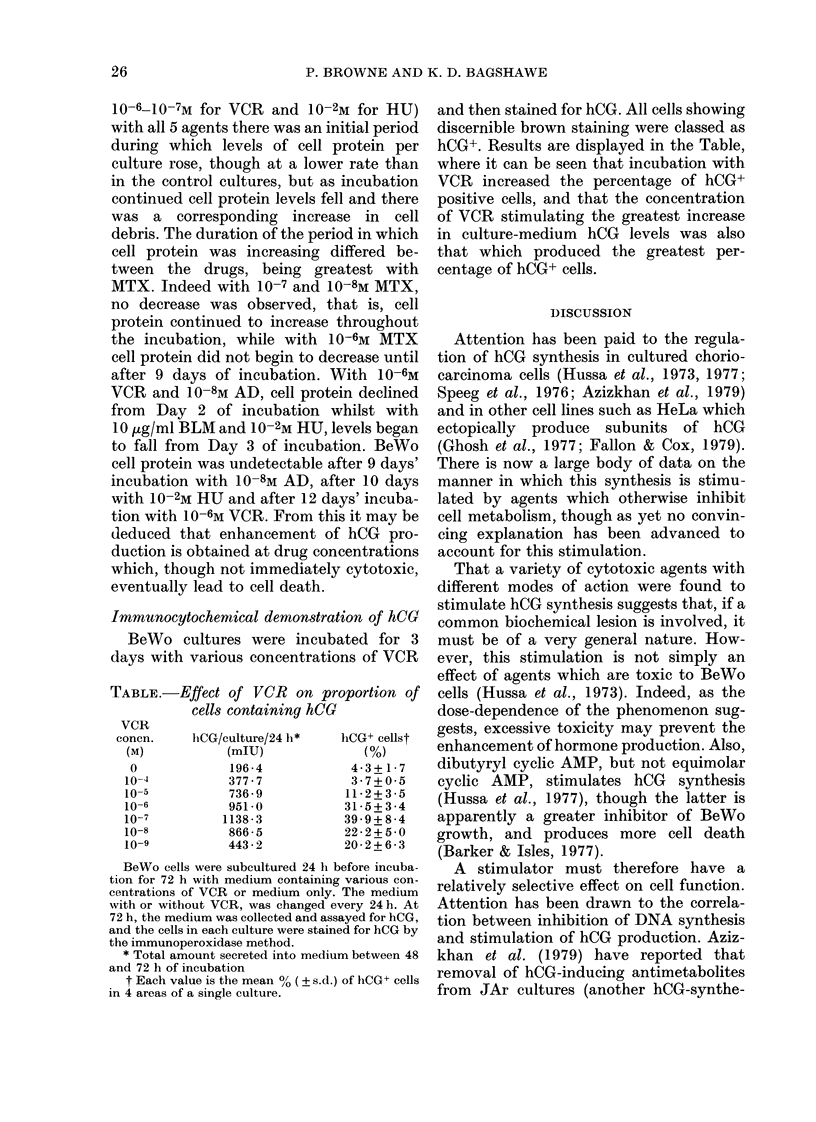
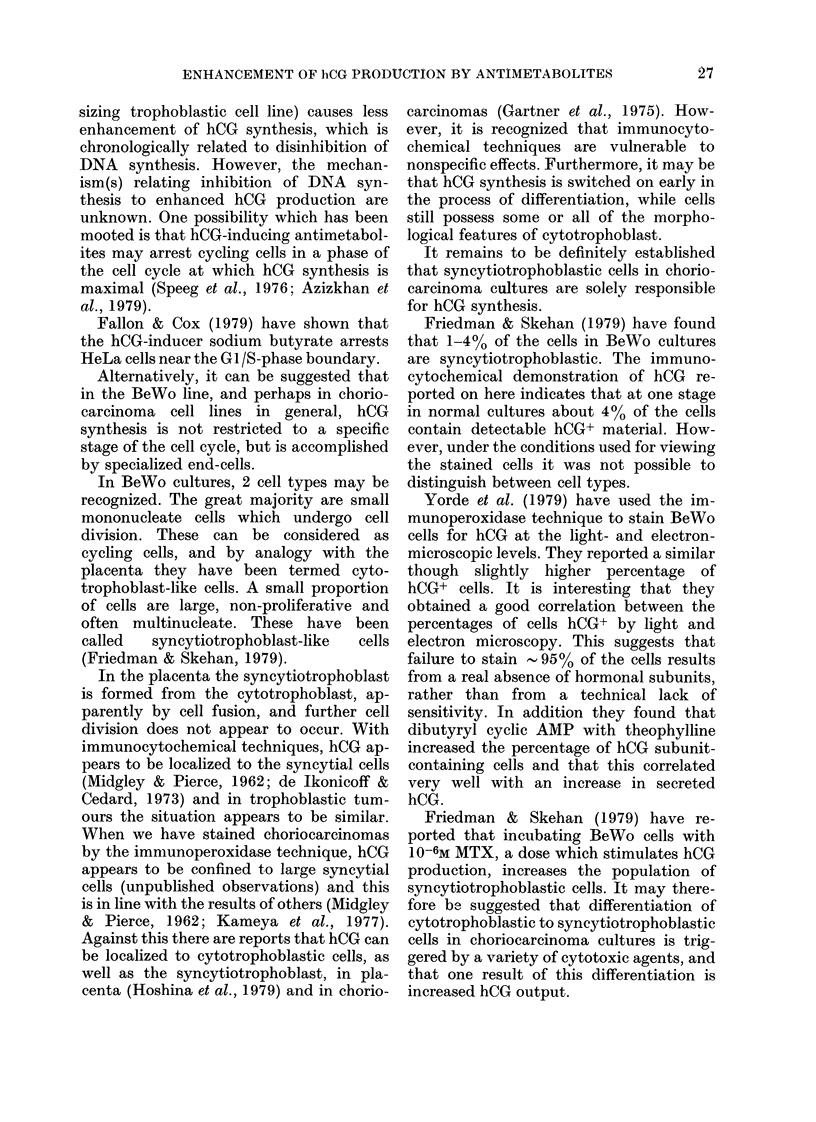
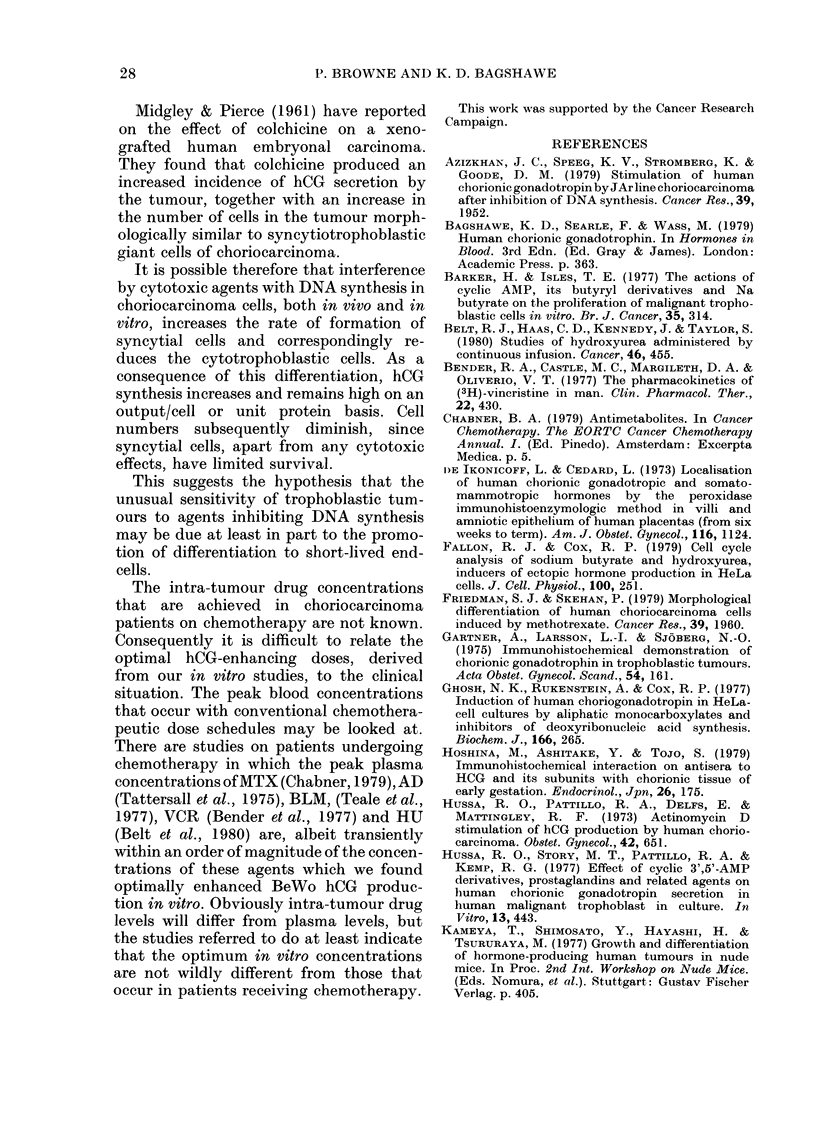

Selected References
These references are in PubMed. This may not be the complete list of references from this article.
- Azizkhan J. C., Speeg K. V., Jr, Stromberg K., Goode D. Stimulation of human chorionic gonadotropin by JAr line choriocarcinoma after inhibition of DNA synthesis. Cancer Res. 1979 Jun;39(6 Pt 1):1952–1959. [PubMed] [Google Scholar]
- Barker H., Isles T. E. The actions of cyclic AMP, its butyryl derivatives and Na butyrate on the proliferation of malignant trophoblast cells in vitro. Br J Cancer. 1977 Mar;35(3):314–321. doi: 10.1038/bjc.1977.45. [DOI] [PMC free article] [PubMed] [Google Scholar]
- Belt R. J., Haas C. D., Kennedy J., Taylor S. Studies of hydroxyurea administered by continuous infusion: toxicity, pharmacokinetics, and cell synchronization. Cancer. 1980 Aug 1;46(3):455–462. doi: 10.1002/1097-0142(19800801)46:3<455::aid-cncr2820460306>3.0.co;2-n. [DOI] [PubMed] [Google Scholar]
- Bender R. A., Castle M. C., Margileth D. A., Oliverio V. T. The pharmacokinetics of [3H]-vincristine in man. Clin Pharmacol Ther. 1977 Oct;22(4):430–435. doi: 10.1002/cpt1977224430. [DOI] [PubMed] [Google Scholar]
- Fallon R. J., Cox R. P. Cell cycle analysis of sodium butyrate and hydroxyurea, inducers of ectopic hormone production in HeLa cells. J Cell Physiol. 1979 Aug;100(2):251–262. doi: 10.1002/jcp.1041000206. [DOI] [PubMed] [Google Scholar]
- Friedman S. J., Skehan P. Morphological differentiation of human choriocarcinoma cells induced by methotrexate. Cancer Res. 1979 Jun;39(6 Pt 1):1960–1967. [PubMed] [Google Scholar]
- Ghosh N. K., Rukenstein A., Cox R. P. Induction of human choriogonadotropin in heLa-cell cultures by aliphatic monocarboxylates and inhibitors of deoxyribonucleic acid synthesis. Biochem J. 1977 Aug 15;166(2):265–274. doi: 10.1042/bj1660265. [DOI] [PMC free article] [PubMed] [Google Scholar]
- Gärtner A., Larsson L. I., Sjöberg N. O. Immunohistochemical demonstration of chorionic gonadotrophin in trophoblastic tumors. Acta Obstet Gynecol Scand. 1975;54(2):161–163. doi: 10.3109/00016347509156749. [DOI] [PubMed] [Google Scholar]
- Hoshina M., Ashitake Y., Tojo S. Immunohistochemical interaction on antisera to HCG and its subunits with chorionic tissue of early gestation. Endocrinol Jpn. 1979 Apr;26(2):175–184. doi: 10.1507/endocrj1954.26.175. [DOI] [PubMed] [Google Scholar]
- Hussa R. O., Pattillo R. A., Delfs F. E., Mattingly R. F. Actinomycin D stimulation of HCG production by human choriocarcinoma. Obstet Gynecol. 1973 Nov;42(5):651–657. [PubMed] [Google Scholar]
- Hussa R. O., Story M. T., Pattillo R. A., Kemp R. G. Effect of cyclic 3':5'-AMP derivatives prostaglandins and related agents on human chorionic gonadotropin secretion in human malignant trophoblast in culture. In Vitro. 1977 Jul;13(7):443–449. doi: 10.1007/BF02615105. [DOI] [PubMed] [Google Scholar]
- Kardana A., Bagshawe K. D. A rapid, sensitive and specific radioimmunoassay for human chorionic gonadotrophin. J Immunol Methods. 1976;9(3-4):297–305. doi: 10.1016/0022-1759(76)90204-0. [DOI] [PubMed] [Google Scholar]
- MIDGLEY A. R., Jr, PIERCE G. B., Jr Effect of colchicine and x-radiation on the differentiation of human embryonal carcinoma. Cancer Res. 1961 May;21:545–549. [PubMed] [Google Scholar]
- MIDGLEY A. R., Jr, PIERCE G. B., Jr Immunohistochemical localization of human chorionic gonadotropin. J Exp Med. 1962 Feb 1;115:289–294. doi: 10.1084/jem.115.2.289. [DOI] [PMC free article] [PubMed] [Google Scholar]
- Pattillo R. A., Gey G. O. The establishment of a cell line of human hormone-synthesizing trophoblastic cells in vitro. Cancer Res. 1968 Jul;28(7):1231–1236. [PubMed] [Google Scholar]
- Speeg K. V., Jr, Azizkhan J. C., Stromberg K. The stimulation by methotrexate of human chorionic gonadotropin and placental alkaline phosphatase in cultured choriocarcinoma cells. Cancer Res. 1976 Dec;36(12):4570–4576. [PubMed] [Google Scholar]
- Tattersall M. H., Sodergren J. E., Dengupta S. K., Trites D. H., Modest E. J., Frei E., 3rd Pharmacokinetics of actinoymcin D in patients with malignant melanoma. Clin Pharmacol Ther. 1975 Jun;17(6):701–708. doi: 10.1002/cpt1975176701. [DOI] [PubMed] [Google Scholar]
- Teale J. D., Clough J. M., Marks V. Radioimmunoassay of bleomycin in plasma and urine. Br J Cancer. 1977 Jun;35(6):822–827. doi: 10.1038/bjc.1977.124. [DOI] [PMC free article] [PubMed] [Google Scholar]
- Yorde D. E., Hussa R. O., Garancis J. C., Pattillo R. A. Immunocytochemical localization of human choriogonadotropin in human malignant trophoblast. Model for human choriogonadotropin secretion. Lab Invest. 1979 Mar;40(3):391–398. [PubMed] [Google Scholar]
- de Ikonicoff L. K., Cedard L. Localization of human chorionic gonadotropic and somatomammotropic hormones by the peroxidase immunohistoenzymologic method in villi and amniotic epithelium of human placentas (from six weeks to term). Am J Obstet Gynecol. 1973 Aug 15;116(8):1124–1132. doi: 10.1016/0002-9378(73)90948-4. [DOI] [PubMed] [Google Scholar]


